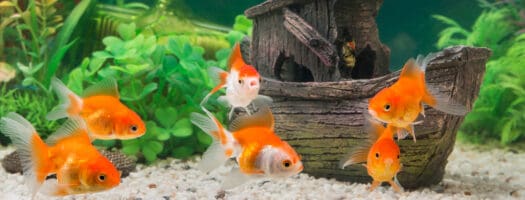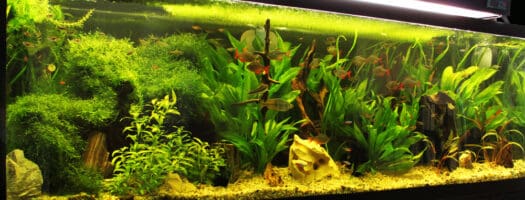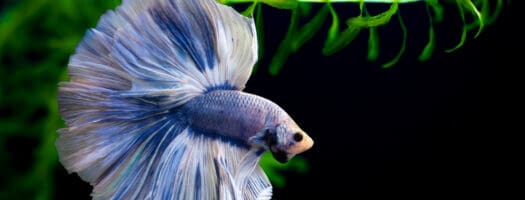How to Lower Aquarium pH Levels the Safe Way
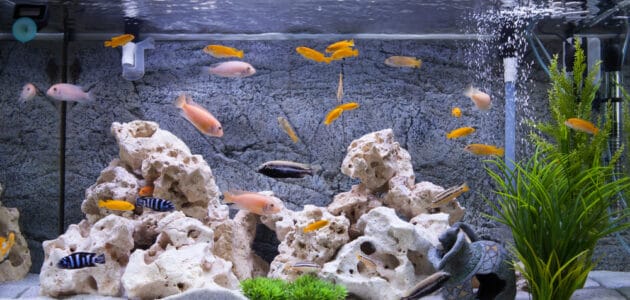
As research in the field continues, the meditative effects of watching fish are becoming more and more clear. Having pet fish can give you a sense of meaningful responsibility and companionship. However, finding your new fish on their sides floating at the top of your tank surely won’t have any positive effects on your mental health, so it’s important to understand how to properly care for your fish.
One of the main factors that affects the survival of domestic fish is the pH level in your aquarium. Without an appropriate and consistent pH level in your aquarium’s water, your fish may experience high levels of stress or even infection, which may lead to death. Understanding how to monitor and adjust the pH level in your aquarium is essential for anyone who owns pet fish or anyone who plans on adding an aquarium to their home.
In general, most people who own aquariums find that they need to lower the pH rather than raise it, since tap water is typically more basic than acidic. And while there are many different products out there that will lower the pH of your aquarium, some are superior to others because of their longevity, safety, and affordability.
What Is the Proper pH for an Aquarium?
The best pH level for an aquarium is typically somewhere between 6.8 and 7.6. Most household tap water has a pH of around 6.5 to 8.5, so chances are your tap water will not need to be adjusted to create a healthy living environment for your fish. Even if the water in your aquarium is outside the preferred range of 6.8 to 7.6, most domestic fish will be able to adjust to the pH level, and will live happy, healthy lives.
If you plan on breeding sensitive fish or wild-caught fish from environments with extremely high or low pH levels, however, you may need to adjust the pH levels in your aquarium. The Japanese Dace (Tribolodon hakonensis), for instance, prefers much more acidic water than most fish(3.8-3.4), while East African Cichlids (Cyphotilapia frontosa) prefer water with a much higher pH (8.0-9.0).
How Do I Test My Aquarium’s pH?
There are a large variety of testing apparatus on the market that can help you correctly gauge your aquarium’s pH so you can see if you need to make adjustments. We have an article about the best pH meters which tells you everything you need to know. Although in most cases a pH adjustment will not be necessary to the health of your fish, it is important to monitor the pH levels in your aquarium.
Reacting to High and Low pH Levels
Extremely low or high pH levels can have dangerous effects to a fish’s health. Extremely low pH levels encourage the solubility of heavy metals like aluminum, copper, lead, and cadmium.
When concentrations of these heavy metals build up in the water, it can result in a toxic environment for your fish. Saltwater fish are particularly susceptible to being harmed by water with a pH level that is too low. Extremely high pH levels can lead to fungal infections in fish and can inhibit their reproduction.
If you do find it necessary to adjust the pH of your aquarium to suit the particular kind of fish you’re breeding, make sure you do it before introducing the fish to the aquarium.
Also, whatever method you use for adjusting pH, make sure that it’s long-lasting and not just a temporary fix. Large swings in pH can be very difficult for fish to withstand. In terms of sustainable and safe ways to adjust the pH of your aquarium, there are several ways to do it.
Should I Use pH Treatment Products From the Aquarium Store?
In short, using aquarium pH treatment products that are sold at aquarium stores should be avoided entirely. These products, particularly liquid pH adjusters, often have short-lasting effects that cause the pH in your aquarium to fluctuate heavily. This can result in a very stressful environment for your fish and may even kill them.
Highly experienced aquarists sometimes utilize these products with extreme care. However, if you are not absolutely sure what you’re doing, there are far safer and more effective ways to adjust your aquarium’s pH. If you do choose to use over-the-counter pH adjusters, make sure that you follow the instructions as closely as possible.
What Are the Best Ways to Lower Aquarium pH Levels?
More often than not, fish owners need to lower the pH level in their aquarium rather than raise it, due to the fact that tap water is typically more basic than acidic. In terms of ways to bring down the pH level in your aquarium, here are the best methods:
-
Introduce Peat Moss to Your Aquarium
Peat moss releases gallic and tannic acid into the water and lowers pH. You can place peat moss either inside the filter in a fine mesh bag or you can place it directly into the aquarium. If you choose to place it directly into the water, however, you should make sure that the peat moss is still in a fine mesh bag and located close to the intake of your water filter. This will help the tannic acid spread uniformly across the entire aquarium.
Peat moss can give a slight tint to the color of your aquarium’s water, almost like the color of tea. If you want to avoid this, you can boil the peat moss before introducing it to the aquarium, which will stop it from causing water discoloration. Just make sure the peat moss is fully cooled down before adding it to your aquarium.
Another added benefit of peat moss is that it absorbs minerals that make water hard and can cause stress to your fish. Through a process called chelation, peat moss removes these minerals from the water and leaves the water soft and comfortable.
-
Add Pieces of Driftwood
Much like peat moss, driftwood naturally releases tannic acid into the water and lowers the pH. However, also like peat moss, driftwood may turn the water in your aquarium a light brownish color. Boiling driftwood in saltwater will get this brown coloring out, and will leave the water in your aquarium looking clear and clean.
When choosing a piece of driftwood to put in your aquarium, it’s important to pay attention to whether or not there are any added chemicals or colors. Some driftwood sold in pet shops can contain chemical agents that may be harmful to your fish. Driftwood designed for reptile habitats may look nice in your aquarium, but it could end up being very harmful to your fish.
If your aquarium is around 10 gallons, one medium-sized piece of driftwood is all you need. If your tank is significantly larger than 10 gallons, you should probably use two or three pieces. Of course, when purchasing driftwood, it is important to take into account the dimensions of your aquarium so you don’t buy a piece of driftwood that doesn’t fit.
Apart from its use in adjusting the pH of your aquarium, driftwood is a great accessory that looks nice in any aquarium. It may even make your fish feel more at home!
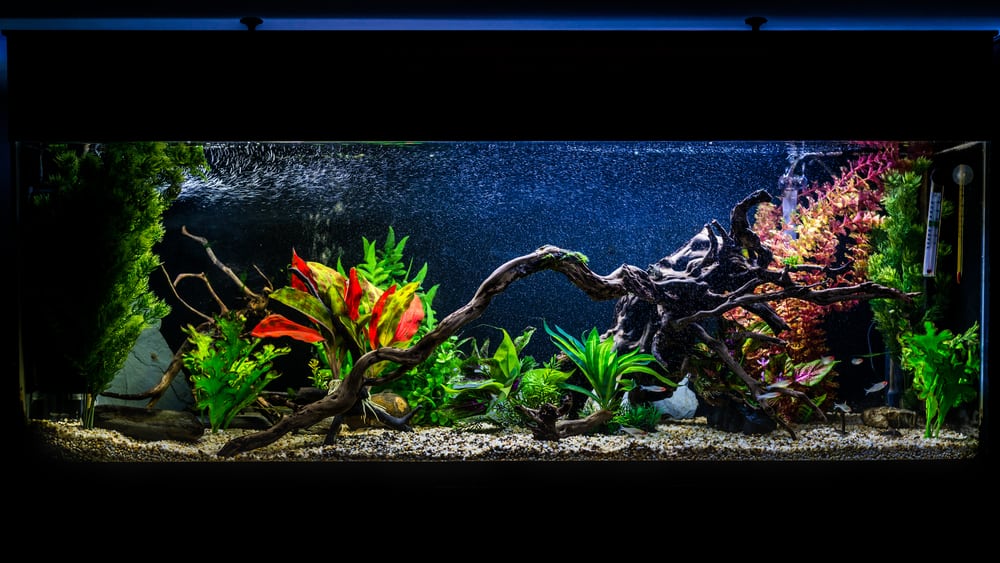
-
Add Almond Leaves to the Water
Almond leaves come from the Indian almond tree (Terminalia catappa) which grows mainly in tropical regions of Asia, Africa, and Australia. If the fish you’re breeding come from these regions, chances are that the addition of Indian almond leaves would benefit them. The leaves of the Indian almond tree, like peat moss and driftwood, release tannic acid, which lowers the pH of water.
Indian almond leaves, however, will also change the color of your water to that brownish or yellowish tea color. And unfortunately, there is no good way to prevent this if you’re planning to use Indian almond leaves for your aquarium. That may not be a bad thing, though. Some have suggested that fish living in brownish or yellowish water experience less stress, since it more closely resembles their natural environment. And since stress is the number one cause of death among domestic fish, this discoloration may actually give your fish a much better chance of survival, even if it may be slightly off-putting to your houseguests.
Indian almond leaves are also reported to have healing properties that can be beneficial to fish experiencing skin problems. It is believed that tannins, the particles which contain tannic acid, kill bacteria, fungi, and viruses, and will help an injured fish recover much more quickly. Indian almond leaves are even thought to have health benefits for humans!
-
Use a Reverse Osmosis Filter
Installing a reverse osmosis filter in your aquarium is possibly the best way to keep your pH levels consistent. Reverse osmosis filters also have many other added benefits such as removing toxins and softening water.
Reverse osmosis filters work by filtering the water in your aquarium through a semipermeable membrane, which allows water molecules to pass through but removes any contaminants which may be in the water. Salts, nitrates, phosphates, and minerals all get trapped in the filter, and then moved to a drainage site. The result is much cleaner and healthier water for your fish.
Most reverse osmosis filters also come with some sort of carbon filter as well, which removes chlorine and harmful organic compounds from the water, since chlorine is attracted to carbon. Chlorine in your aquarium environment can have a negative effect on your fishes’ health and on the reverse osmosis system itself if levels get too high.
If you’re looking to adjust the pH levels in your aquarium, make sure that your reverse osmosis filter comes with either a deionization cartridge or a remineralizing cartridge. If you need your aquarium’s pH to go down, a deionization cartridge will trade ions in the water with hydrogen and hydroxide ions, thus lowering the pH. Reverse osmosis filters equipped with deionization cartridges produce such pure and neutral water that they are often used in laboratories and medical facilities. If you wish to raise the pH level in your aquarium, a remineralizing cartridge will redeposit minerals into the water after the reverse osmosis filter has removed them. This can be helpful for fish who thrive in a more alkaline environment.
Reverse osmosis filters also have the benefit of regulating the general hardness of the water in your aquarium. Fish often prefer the general hardness of their natural environment, but water that is too hard, meaning it contains too many minerals, can inhibit reproduction and lead to other health problems in fish.
-
Add Deionized Water to Your Aquarium
Deionized water is also sold in bottles that can be added to your aquarium’s water. This is more of a temporary fix than installing a reverse osmosis filter, because you will have to continually add more deionized water if you want to keep pH levels in your aquarium stable.
Deionized water is essentially water in which all ions have been removed. Deionized water is meant to have a pH as close to 7.0 as possible. However, when it comes in contact with carbon dioxide in the atmosphere, carbonic acid is produced, which can lower the pH to as low as 5.5. For those who wish to lower their aquarium’s pH, adding deionized water carefully is a decent temporary fix. For anyone looking to increase the pH of their aquarium, deionized water is probably not the way to go.
-
Lower Your Aquarium pH With Vinegar
Though it may seem slightly counterintuitive, adding vinegar to your aquarium can lower the water’s pH and create a more comfortable environment for your fish. Vinegar contains acetic acid, which combines with oxygen and brings the pH levels in the water down.
Diluted white vinegar is really the only type of vinegar that should be used in an aquarium. Other types, such as red wine vinegar or apple cider vinegar, can contain other organic substances which may pose a threat to your fishes’ health.
Adding vinegar to your aquarium is probably not the most sustainable or safe way to lower your aquarium’s pH. However, it makes for a good quick fix, since most people have diluted white vinegar in their homes.
Unfortunately, to achieve the long-term desired pH level, you would have to continually add in a solution of water and vinegar. It is recommended that you don’t use more than one milliliter of vinegar per gallon of water. Any more than that, and you could make the water too acidic and toxify your fish.
How Do You Acclimate Fish to a New Tank?
If you’re planning on moving fish from a tank at a pet store or from the wild into a home aquarium, chances are there will be some amount of difference in the pH between the two bodies of water. Therefore, it is very important to properly acclimate your fish to their new environment, or else they may die just hours or days after being introduced to your aquarium. To prevent your fish from experiencing high levels of stress when entering a new environment, there are important steps you should take to ensure that your fish are properly acclimated.
Ask About the Water Conditions Wherever You Purchase Your Fish
Once you know the kind of conditions the fish have been living in, you can compare that to the conditions in your home aquarium and try to make them as similar as possible. Ask about the pH level, the salinity, and the temperature of the water. If the differences are large, the process of acclimating your fish will take longer. If the differences are very small, the process can take as little as 30 minutes.
Take the Fish From the Store in a Bag of the Water They Were Previously In
Keeping the fish in the same water conditions they were previously in will ease the transition from their previous conditions to the conditions of your aquarium.
Create an Acclimation Container in Your Aquarium
The best way to do this is to float the bag that your fish came in on the top of your aquarium. This will allow the fish to adjust to the temperature of your aquarium in a gradual manner.
Next, you should cut open the top of the bag and add a cup of the water from your aquarium into the bag. Wait for about ten minutes while paying close attention to how the fish react. If there are no signs of stress in the fish, feel free to add another cup of the water from your aquarium.
Repeat this process until the bag is nearly full. Finally, once the bag is nearly full of water, scoop the fish out of the bag with a net and place them in your aquarium. Continue to watch the fish for any signs of stress. If you don’t see any, then your fish are good to go!
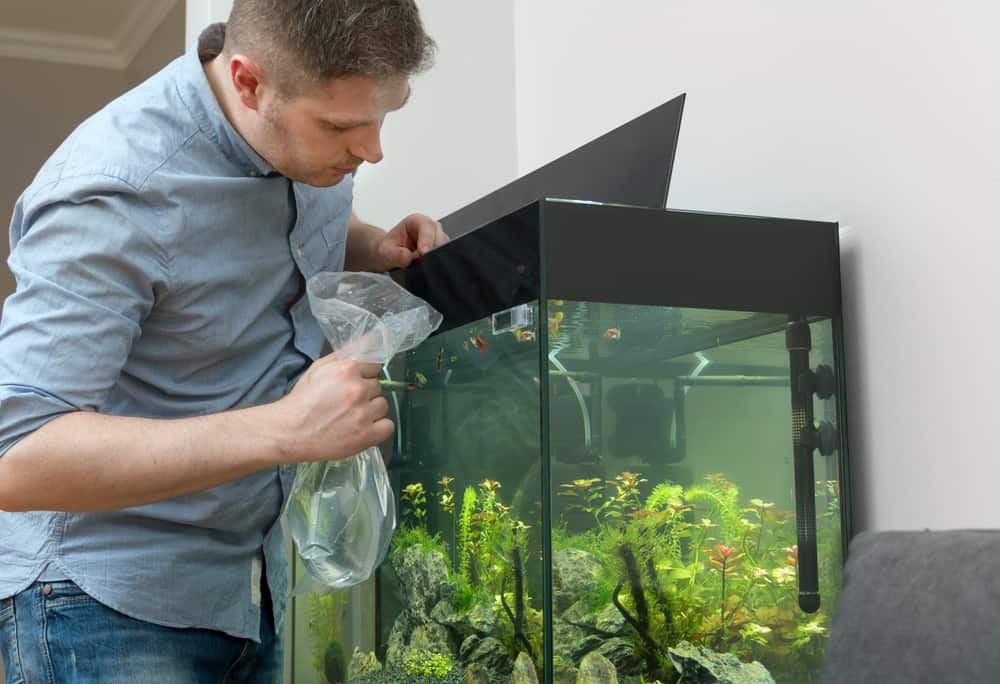
In summary, probably the best way to lower the pH in your aquarium without consistent maintenance is to install a reverse osmosis filter with a deionization cartridge. These filters, however, can be a bit more expensive than other options.
Introducing driftwood, peat moss, or Indian almond leaves to your aquarium environment can naturally bring down the pH by releasing tannic acid into the water. It should be noted, though, that all three of these options can discolor your water and make it less clear, so it’s important to treat these products before putting them in your aquarium if you don’t want that to happen.
Using chemicals and over-the-counter pH adjusters should be an absolute last resort. Misuse of these products can be extremely harmful to your fish.
Regardless of which method you use to reduce your aquarium’s pH, it is vitally important to consistently monitor the pH levels in your aquarium. There are many devices on the market that can be used to monitor pH, such as our best pH meters, or simple litmus paper also works.
Balance in All Things
When introducing new fish into your aquarium, make sure to take the necessary steps to acclimate them to the new environment. And once your fish have settled into their new home, ensuring that there are no major fluctuations in the pH level will be crucial to their survival.
